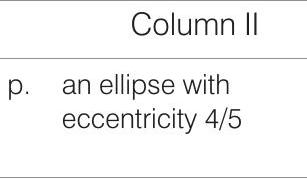Complex Numbers 2 Question 30
31. Match the statements of Column I with those of Column II.
Here,
| Column I |  |
|
|---|---|---|
| A. | The set of points contained in or equal to |
|
| B. | The set of points contained in or equal to |
q. the set of points satisfying |
| C. | If points in or equal to |
r. the set of points satisfying |
| D. | If equal to |
s. the set of points t. satisfying the set of points satisfying |
the real part of
(2010)
Fill in the Blanks
Show Answer
Answer:
Correct Answer: 31. True
Solution:
- A. Let
B. We have
Let
D. Let
Then,






